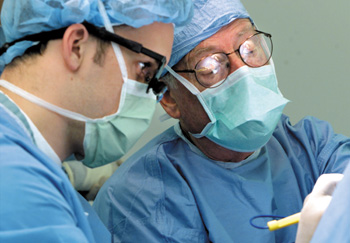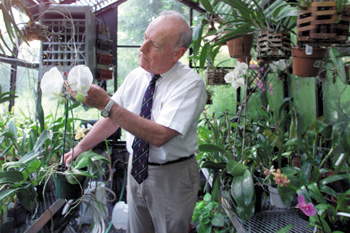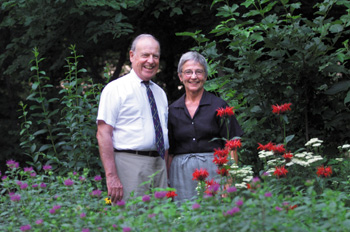
Dr. James O'Neill, right, and Dr. Jon Eliason, a resident, perform an annoplasty on a 10-month-old patient last week. (photo by Dana Johnson)
Teacher, surgeon, friend — Administrative duties end, teaching continues for Dr. James A. O’Neill

O’Neill works in his orchid greenhouse after a long day in surgery at Vanderbilt. (photo by Dana Johnson)

O’Neill and wife Susan have been married 42 years and share a love of gardening. (photo by Dana Johnson)
It’s 7 a.m. in Medical Center East, just outside the pediatric operating suites. Nurses are blurs of blue scrubs scurrying in and out of rooms as residents and attendings check the board and pint-sized patients shuttle through the hallways prone atop transports.
When the buzz of the milieu rises and settles into its typical busy drone, Dr. James A. O’Neill Jr. walks briskly onto the scene, smiling broadly, as if early morning work did his bones good, and with an air of confidence and command.
O’Neill’s appearance is regular, although infrequent, about once a week. He’s anchored to a desk by administrative titles: John Clinton Foshee Distinguished Professor of Surgery, chair of the Section of Surgical Sciences, Surgeon in Chief. Maybe his smile more recently beams because he’s about to shake those titles. On July 1 he will no longer officially lead Vanderbilt’s surgical services, although he’ll still be around. Dr. R. Daniel Beauchamp will be the new director of the Section of Surgical Sciences.
But it’s more likely that O’Neill’s personality projects a larger image.
“He remembers everyone’s name,” surgical nurse Lori Graves, RN, says of O’Neill. “He really is nice. He’s a gentleman.”
“He’s very kind,” adds Carolyn Maness, RN, a charge nurse in the OR. He deploys the same sense of grace and good manners around an operating table as you would expect around his mother’s dining table on Mother’s Day.
Administrative assistants warm to this surgeon’s smile and morning greeting – by name. His patients’ parents glow when describing him. “I just can’t go on enough about how good he is,” Robbie Stroud, the mother of a 14-year-old patient says. “He told us (before her son David’s surgery), ‘I’ve never lost a patient, but I’ve lost a few mothers.’ He’s very comical.”
“I think he’s great,” Tammy Meredith, the mother of 19-month-old Isaac, says. “He calls Isaac ‘Big Guy’ because he was so small at birth.”
Neither mother was aware of the bullets on O’Neill’s CV. “He’s just like family,” Meredith says.
But, says Dr. Wallace Neblett, chairman of Pediatric Surgery, “Any pediatric surgeon in the world has heard of Dr. O’Neill.” Any pediatric surgeon should. O’Neill wrote the book on the specialty – literally. Pediatric Surgery, of which he is lead author, is now in its fifth edition.
Skill of relations
Surgery requires skill. But, O’Neill says, making surgery effective requires art – art of communication, of relating to people, the art and capacity of empathy.
Being a surgeon, he says, means “you’re a doctor first. The fundamentals of medicine span all aspects of medicine. You have to have appreciation for the fact that you’re dealing with a human being, understand them, that they’re ill, and respect that,” he says. “You have to understand science, but also developmental psychology, family relationships. Surgery is not just an operating event.”
And pediatric surgery is more than work. “It’s fun. You see babies, teen-agers. You see all the stages of development.,” he says. “And you can have fun with kids, then you can help them along.”
Perhaps O’Neill learned these lessons growing up, witnessing first-hand an American dream.
O’Neill, who went to college at Georgetown and medical school at Yale, and who for years has been in demand as a speaker on pediatric surgery around the world, might not appreciate his accomplishments so much if he didn’t realize his roots. His father, Jim Sr., was orphaned at 3 years old when his father died and his mother could not afford to rear him alone. At 15, the elder O’Neill left school after eighth grade to make his way in the world in the family’s hometown, one of the most challenging cities, but one reeking with opportunity – New York.
“He was a great inspiration to me,” the junior O’Neill says. “He was well read. He told great stories. He was a philosopher. He was not a man to put on a lot of frills, never put on airs.”
His father finished high school at night, worked during the day as an office boy and eventually became a Manhattan corporate executive. He encouraged young Jim and his other son, William, to follow in his footsteps. William did, and became chair of Merrill Lynch futures trading. Jim, however, was more interested in science. “My father discouraged it,” O’Neill says. “He said, ‘Being a doctor is a hard life.’ I could never see that.”
And maybe, O’Neill says, his choice of a pediatric surgical career was influenced when his sister died as an infant of a congenital heart defect. “Maybe it just raised a thought in my mind,” he says.
In the summer between his second and third years at Yale, O’Neill was working on the pediatric service one Saturday morning. “This infant came in, 3-months-old, who looked to be deathly ill,” he recalls. “Nobody knew the problem, from the attending to the chief resident, even the pediatrician on call. A surgeon came in, put his hand on the child’s abdomen and made a diagnosis. He said, ‘We have to take this child to the OR.’ He saw the whole picture, figured out the problem, then had a solution. That’s the day I said I would be a pediatric surgeon.”
Surgical journeyman
Near the end of medical school, O’Neill told his advisor he wanted to try a surgical internship with a pediatric rotation. The only one in the country at the time was at Vanderbilt with the renowned Dr. H. William Scott. His advisor said, “Once you get that out of your system, come back here and finish your residency with us,” O’Neill says. “I got here and it was such a great educational residency I liked it better than Yale.”
O’Neill’s “first job,” he says, was at Louisiana State University’s medical school in New Orleans. He had finished two residencies, a fellowship and a tour in the Army. And after two years at LSU he was a full professor and chief of pediatric surgery. He was plowing the field of pediatric surgery when it was just a back lot.
Scott lured O’Neill back to Vanderbilt in 1971 to develop here the concept of a children’s hospital within a hospital. He would be the only full-time pediatric surgeon for six years. In 1981 he caught the eye of the Children’s Hospital of Philadelphia and was named their surgeon-in-chief. Seven years later he occupied the position vacated by Dr. C. Everett Koop, who left to become Surgeon General of the United States.
It was an opportunity to build a program in pediatric surgery that attracted him to Philadelphia he says. And in 1995, Vanderbilt turned to him to build up all its surgical programs. Under his helm, income to the department has increased 60 percent. Funding from research has elevated the program from 48th to 28th and residents now spend two years in research in addition to their five clinical training years in general surgery. The section’s ability to attract top-ranked medical students to its residency ranks has become one of the strongest in the nation.
Two ever-present elements in O’Neill’s career are research and instruction. “One of his finest qualities is his unwillingness to give up the belief that there is a lot of science to be done,” says Dr. Eric Neilson, Hugh J. Morgan Chair in Medicine and Chair of the department. (O’Neill led the search committee that selected Neilson. “We both went to the same high school in Long Island,” O’Neill says, again finding a way to connect the personal with the professional lives.)
“While a surgeon’s life is a busy and hectic one, Jim is able to compartmentalize that stress and devote time to his discipline by stimulating research in his department,” Neilson says. “In a procedure-based field, it’s very time consuming. A lot of people just give up on research. Jim doesn’t.”
Also, Neilson says, “He is able to express his feelings so well; they’re heard through the noise. He can disagree without being disagreeable. It’s a gift in a tense field.”
In a recent six-hour procedure, O’Neill was instructing the pediatric chief resident, Dr. Jon Eliason, through the correction of Robbie Stroud’s son’s chest. The boy’s rib cartilage was growing too fast, resulting in a depression on the boy’s right side of his chest, and a protrusion on the left. His heart and lungs would be squeezed and their ability to function compromised if the defect were not corrected.
Like coaching a promising athlete, O’Neill’s guidance is a mixture of explaining the procedure, advising of possible pitfalls and, as always, finding ways to relate to the young surgeon and the other staff. He talks basketball and vegetables with the scrub nurse. He soaks his own sponges and helps change a light bulb. “You have to find a way to make yourself useful when people are working,” he says.
And always, there’s instruction.
“He teaches about everything – early anesthesia, the evolution of a surgical technique. There are very few topics he can’t teach with authority,” Eliason said later. While any surgeon’s knowledge about any one topic might be encyclopedic, Eliason says, “Dr. O’Neill’s the guy with the full-volume set.”
At medical school in Minnesota, Eliason heard about O’Neill. “I thought it was a little unusual to have a peds surgeon chair a department,” he says. “Then I heard he was the guy who took over at CHOP for C. Everett Koop. I thought he was probably knowledgeable and used to being in charge. After my interview here, it struck me as a place where the head of the department and the administrative leaders had a very personal investment in the experience residents receive.”
Familial ties
While an undergraduate, a childhood friend of O’Neill’s kept telling him about a girlfriend of hers, a fellow student at Vasser. Susan was a math major. Finally, she and Jim met. His charm sparked her interest. “He’s not named O’Neill for nothing,” she says now. “He has a good Irish sense of humor.” He grins. “I chased her for three years,” he says. And then, with a serious expression, “She finally caught me.” They were married following his medical school graduation in 1959 and before coming to Vanderbilt.
The couple had an austere beginning in a Nashville duplex. “The rent was $68.50 a month, and it’s a good thing because my salary was $72.50,” O’Neill says. Susan worked until the first of their three children, James A. O’Neill III, was born. The couple later adopted Elizabeth, then Susan gave birth to Kathryn. All three children live in New York. James and Elizabeth are married, and the O’Neills have four grandchildren.
Now the couple is looking forward to putting the years of career building behind them. Dr. O’Neill still will be a faculty member at Vanderbilt. He will consult on the construction of the new Monroe C. Carell Children’s Hospital at Vanderbilt, revise his textbook, help to futher develop te Meharry-Vanderbilt Alliance, and continue his clinical duties.
But he’ll spend more time at home and with family than the past 40-odd years have allowed. And he’ll likely carry on the talents – namely communicating, relating to and instructing people – by which he’s made his living. One place you’ll find him is behind the couple’s home in yet another extension of his skills – a greenhouse kept as orderly as an OR – not too cool, not too hot, the humidity just right, free of bacteria and parasites. In it are about 60 varieties of orchids, many of them his own hybrids. There’s a science to growing orchids from seeds, like patching a child’s chest or reconstructing a bowel or separating conjoined twins. And in the greenhouse, just as with the fruits of his surgical labors who walk and breathe and carry on their lives with fewer complications thanks to his surgical advances, there’s something in bloom all year.













